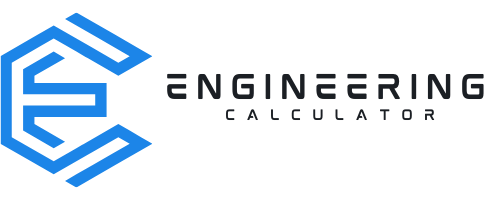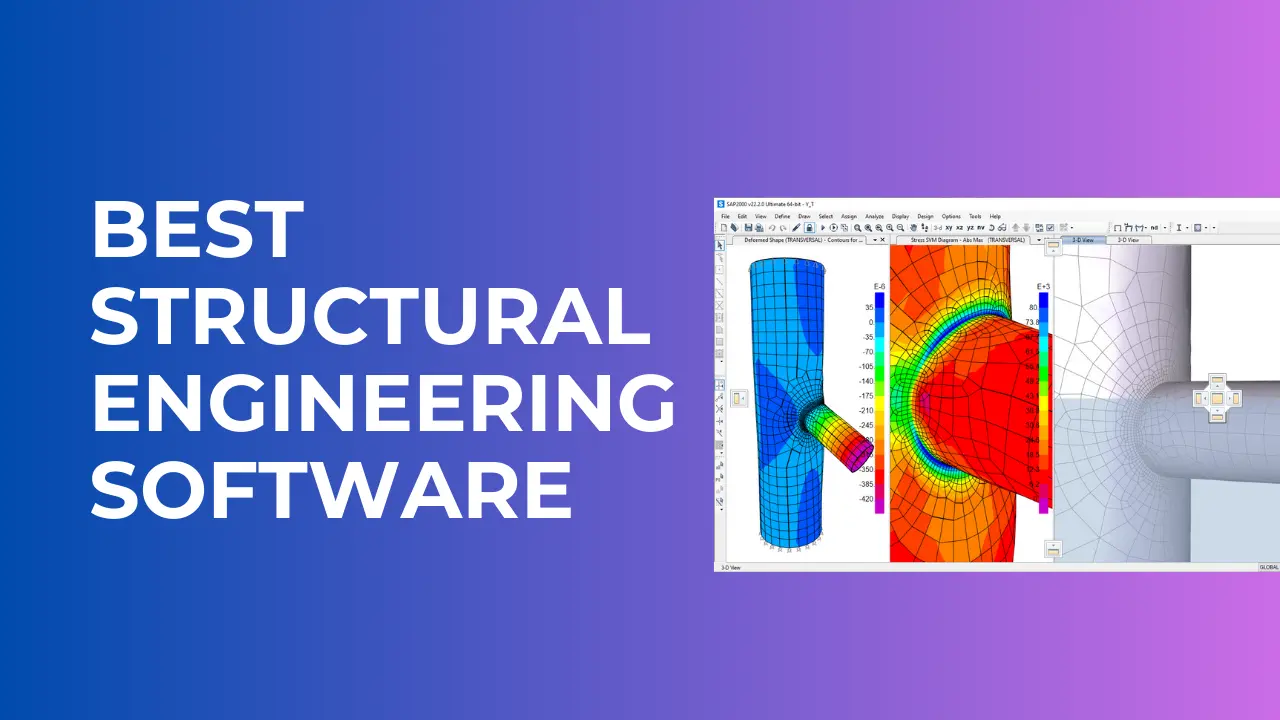Structural engineering is complex and challenging work, requiring a lot of precision and planning.
As an engineer, you need to have the right tools at your disposal to ensure that the project meets its desired goals – whether it’s constructing new infrastructure or providing support for existing structures.
With the abundance of structural engineering software out there, it can be difficult to decide which one will best suit your needs, so we’ve rounded up some of our favourite picks to make finding the perfect software a breeze!
22 Best Structural Engineering Software for You
- ETABS
- SAP 2000
- STAAD PRO
- RAPT structural engineering software
- Autodesk ROBOT Structural Analysis Professional
- Tribby3d
- Tekla Structural Designer
- RAM Concept
- Microstran structural engineering software
- Strand 7
- Safe
- SPACE GASS
- MIDAS
- RAM Connection
- RAM Structural System
- Adapt Edge
- ProtaStructure
- AutoCAD
- Autodesk Revit
- SOLIDWORKS
- SkyCiv
- SketchUp
22 Best Structural Engineering Software You Must Use In [2024]
1. ETABS
Computers and Structures Inc (CSI) developed software called ETABS which revolutionized the way structural engineers analyzed and designed structures in the early 1990s.
One of the software’s strongest features is the functionality around designing and analyzing multi-story structures, which is essential for modern architectural designs.
ETABS uses finite element analysis (FEA) and numerical simulation methods in the background, making it a powerful engineering tool for calculating seismic response, gravity, and wind loads. Unbelievably, ETABS was used to model the world’s tallest structure, the Burj Khalifa, by a firm in Chicago.
The software was also used to consider p delta effects for the same structure. Overall, ETABS is an ideal FEA-based software for analyzing and designing beams, columns, and slabs, with its multi-story feature making it a top choice for working with modern architectural designs.
2. SAP 2000
Computers and Structures Inc (CSI), a renowned engineering software company, developed SAP 2000, a powerful structural analysis and design software package for civil engineers.
Unlike its counterpart, ETABS, SAP 2000 is designed primarily for general-purpose structural engineering systems.
From fundamental configurations to advanced 3D models, this versatile software can be relied upon for accurate design and analysis at every stage of the project.
What’s more, SAP 2000 boasts a remarkable optimization module that is perfectly equipped to handle even the most complex structures, like shells and membranes. Suffice it to say, that choosing SAP 2000 is choosing excellence in engineering design.
- [High Speed RAM And Enormous Space] 32GB high-bandwidth RAM to smoothly run multiple applications and browser tabs all at once; 128GB eMMC + 1TB PCIe NVMe M.2 Solid State Drive allows to fast bootup and data transfer
- 【AMD Ryzen 3 7330U Processor】Unleash extraordinary performance with a powerful 4-core architecture and advanced processing capabilities, ensuring effortless handling of demanding tasks and impressive power efficiency for long-lasting endurance.
- Purposeful Design: Travel with ease and look great doing it with the Aspire’s 3 thin, light design.
- 【Powerful Capabilities】 MALLRACE AX17 Laptop computer powered by latest 12th generation Alder Lake N97 processor (4C/4T, 6MB Cache,12W, base frequency 2.0GHz, up to 3.6GHz, 7 Lithography), performance is much higher than Celeron N5095 or Pentium N5030. Built-in 16GB DDR4 and 512GB SSD for more powerful multitasking capabilities.
- [This is a Copilot+ PC] — A new AI era begins. Experience enhanced performance and AI capabilities with Copilot+ PC, boosting productivity with security and privacy in mind
- 【Processor】Equipped with Intel Core i3 (up to 4.40Ghz, 6 cores, 8 threads), it offers the ideal set of features to turn you into an unstoppable machine.
- 【High Speed RAM And Enormous Space】20GB high-bandwidth RAM to smoothly run multiple applications and browser tabs all at once; 1TB PCIe NVMe M.2 Solid State Drive + 128GB eMMC allows to fast bootup and data transfer
- Supercharged Process: The 13th Gen. Intel Core i7 processor delivers the ultimate immersive experience in gameplay, multi-task work and productivity.
- Supercharged Process: The 13th Gen. Intel Core i7 processor delivers the ultimate immersive experience in gameplay, multi-task work and productivity.
- 【Processor】Intel Pentium (4 Cores, 4 Threads, Max Boost Clock Up to 3.3Ghz, 4MB Cache). Intel UHD Graphics. This 14-inch laptop is also equipped with Windows 11 Pro, which makes your work or study easy and convenient.
3. STAAD PRO
When it comes to designing and modelling structures in 3D, STAAD PRO is a popular structural analysis software that boasts unmatched flexibility.
Whether it’s designing structural frames of steel, concrete, cold steel, wood, or aluminium using building design codes from around the world, this software can handle almost any type of structural system.
Some engineers and architects argue that it is the most complete software package in the industry.
By applying various loading conditions, this software can help you explore the behaviour and limits of your structural system to make sure it can withstand any challenge that comes its way.
With STAAD PRO, you can rest assured that your structure is supported with the highest level of precision and reliability.
4. RAPT structural engineering software
When it comes to designing and analyzing reinforced and post-tensioned concrete systems, RAPT structural engineering software is a game-changer.
Developed by an Australian company, this software has become a go-to tool for practising structural engineers.
What sets RAPT apart from other design tools on the market is its comprehensive analysis modules that are specifically tailored for concrete systems.
The software supports a wide range of major design standards, including Eurocode-2, AS 3600-2100, BS 8100, and ACI 318/99 UBC, and users can also adjust the settings to include other standards if needed.
With RAPT, engineers can rest assured that their concrete designs are optimized for maximum performance and safety.
5. Autodesk ROBOT Structural Analysis Professional
Robot Structural Analysis is a powerful software developed by Autodesk that offers a wide range of tools for advanced structural analysis.
Not only can it handle standard-sized buildings, but it can also accommodate larger and more complex structures, making it an ideal option for architects and engineers working on ambitious projects.
One of the key benefits of Robot Structural Analysis is its ability to verify code compliance, ensuring that any structures created using the software are robust and safe.
Additionally, the tool can seamlessly integrate with Revit, using BIM technology to minimize the chance of mismatched models with the architectural design.
With its comprehensive set of features, Robot Structural Analysis is quickly becoming a go-to tool for engineering professionals across the globe.
6.Tribby3d
Tribby3d is the ultimate structural engineering software that every professional designing single-story and multi-story buildings should have.
What makes it stand out from its competitors is its cloud-based nature, which enables users to access it directly from their web browsers without the need to download and install it.
Tribby3d calculations are accurate, and users don’t need to have a detailed finite element model to work with it, which is super convenient when it comes to early-stage design.
Besides being user-friendly, the program comes with a comprehensive UI and visually appealing outputs that help structural engineers depict element loading and column load takedowns effectively.
Best of all, users can export their Tribby3d analysis results in both DXF and Excel files, which are ready for further design.
Tribby3d is without a doubt the go-to software for engineers who want to optimize their workflow and ultimately improve their design output!
7.Tekla Structural Designer
Managing complex structural design projects can be a challenging task for any engineer. That’s why Tekla Structural Designer comes as a breath of fresh air.
This 3D structural analysis and design software offers a unique set of features that not only simplify the design process but also optimize concrete and steel design.
Whether you’re designing a small building or a large-scale structure, Tekla Structural Designer analyzes the structure efficiently and provides automated design options to suit your chosen building code.
A remarkable advantage is that Tekla Structural Designer can easily collaborate with BIM, making it possible to consider all members in the overall building design in one seamless process.
In short, Tekla Structural Designer is an innovative software that streamlines and optimizes the structural design for any project complexity.
8.RAM Concept
Designing concrete slabs can be a daunting and complicated task, but with RAM Concept software, it doesn’t have to be.
This software has become a game-changer in the industry with its focus on reliability and practicality.
What sets RAM Concept apart from other systems is its ability to design floors and foundation slabs economically and efficiently, without sacrificing quality.
One of the most impressive features of this software package is the way it models complex geometries, making it easy to analyze flat slabs of multi-story buildings in 3D.
Whether you’re an engineer, architect, or construction professional, RAM Concept is a must-have tool for designing and analyzing concrete slabs as efficiently and effectively as possible.
9. Microstran structural engineering software
Efficiency and productivity are what every engineer strives for when working on a project, and Microstran offers just that.
The general-purpose structural analysis software is equipped with powerful modules specifically designed for the designing of steel members and connection details.
With Microstran, engineers can take advantage of the modelling commands, which can help build structures in a fraction of the time it would take to do it manually.
As a result, engineers can produce multiple design options quickly and efficiently and use those options to make informed decisions.
With the added bonus of being able to export to almost every format used commonly in the industry, it’s no wonder why Microstran is a favourite amongst engineers.
10. Strand 7
Strand 7 is a software package that offers a range of tools and features to make modelling easier and more efficient.
One of the standout tools in the package is the group tree tool, which allows users to organize and simplify complex models. This feature enables users to quickly build and assess models with ease.
In addition, Stand 7’s visual environment provides a user-friendly interface that makes modelling a breeze. The ability to open multiple models at once and shift elements between them is another advantage, as it helps streamline the modelling process.
Perhaps most importantly, Strand 7 offers a deeper study of each element, including forces at each point. This feature provides a level of insight and understanding that is invaluable for anyone working in modelling and simulation.
11. Safe
When it comes to creating layouts and producing drawings, SAFE is the go-to software for many designers and engineers. One of the reasons that make SAFE stand out is its intuitive environment.
It enables users to effortlessly carry out tasks, from creating models of base mats, footings, and foundations to designing PT beams and reinforced concrete structures.
This software offers a single-user interface that caters to analysis, designing, and reporting, making workflow quick and straightforward.
Not only that but the values can be displayed promptly while analyzing the model, making it an efficient tool. Furthermore, SAFE offers active connections to several third-party products and CSI software, providing a seamless user experience.
These features, coupled with the tendon editor, which helps create tendon profiles with automated layouts, and the SAP Fire Analysis Engine that performs both Eigen and Ritz analysis, make SAFE a reliable and comprehensive design tool.
12. SPACE GASS
For structural design professionals around the world, SPACE GASS is a go-to tool for 3D and multi-purpose structural analysis and design software.
Its wide range of features helps to efficiently design structural members such as beams and columns, while also enabling the design of trusses of different varieties with ease. What’s more, the software makes it simple to export outputs to other CAD and BIM software.
Thanks to its smart matrix solver, which utilizes multi-core processors to deliver faster solutions, simulations can be completed in record time.
In fact, SPACE GASS’s unique solving mechanism and intuitive user interface make it the preferred option among structural steel frame designers who are seeking powerful, reliable software.
13. MIDAS
Midas software for structural design and analysis stands out among its peers with two powerful components – Midas Gen and Midas nGen.
Using cutting-edge computer graphics and a robust Solver, Midas Gen can handle everything from conventional to complex structures.
This means higher standards of efficiency and productivity for structural design, as well as unparalleled convenience and versatility.
Meanwhile, Midas nGen takes things a step further with a complete design package capability, including 3D modelling, analysis, and design to 2D drawings.
This all-in-one design system is a valuable asset for any designer who wants to save time and produce high-quality deliverables like structural calculation reports and quantity takeoffs.
Overall, Midas software is a game-changer for structural design and analysis.
14.RAM Connection
Steel structures require both strength and precision in their design, and the connections used in these structures require a tool that can handle their complexities.
This is where RAM Connection comes in, developed by Bentley specifically for designing steel connections.
As part of the same family of products as STAAD Pro and RAM, RAM Connection offers seamless interoperability with other design tools from Bentley.
One of the key advantages of RAM Connection is the ability to optimize connections for both efficiency and cost-effectiveness.
With this tool, engineers have greater control over the design of steel connections, making them an essential part of the design process for any steel structure.
15.RAM Structural System
Have you ever found yourself losing hours to the tedious task of designing and documenting steel and concrete buildings? RAM can offer you a complete solution that will save you valuable time and increase your productivity.
The software can handle both simple and complex designs while still being compliant with local and international building codes.
Its capabilities are impressive- you can easily analyze gravity and lateral loads, integrate slab and foundation design, design lateral resisting frames, and even detail and schedule concrete reinforcement.
And let’s not forget about the peace of mind that comes with knowing your foundations and individual structural components were designed with the utmost accuracy.
With RAM, you can streamline your workflow and focus on what really matters- creating impeccable structures.
16. Adapt Edge
The days of tedious modelling and analysis processes for concrete structures are long gone with ADAPT-Edge. This software has revolutionized the engineering industry as it can analyze an entire concrete building structure from the roof to the foundation, considering load reactions to the foundation.
By combining the analysis and design process into one model, Edge simplifies the whole process. The best part? It’s specifically designed for the rapid modelling of concrete structures, making efficiency the name of the game.
Even better, you have the option to add pre-stressing or post-tensioning to any slab or beam member. No longer will designers struggle to create accurate building models as the software can easily integrate with Revit Structure.
ADAPT-Edge has brought a new level of speed, accuracy, and simplicity to concrete building design.
17.ProtaStructure
ProtaStructure is, no doubt, one of the most efficient 3D structural software on the market for modelling and designing steel and building structures.
From the moment you begin designing your project, its innovative BIM integration ensures that you have all the tools required to design, model, analyze, and produce high-quality drawings and design documentation.
With the ProtaDetails and ProtaSteel options, you can compare different schemes, automate your design using one central model, and swiftly design your proposed project.
What makes ProtaStructure stand out is the reduction of time spent on modelling and design, leading to higher productivity levels.
Thanks to this software, you design and accomplish more in less time, making it ideal for architects, engineers, and construction professionals.
18.AutoCAD
The structural engineering industry depends on specialized software to get the job done effectively and efficiently.
Among these tools, one stands out as a particularly popular choice: it’s a feature-packed software that boasts industry-specific toolsets and advanced automation.
With the COUNT Command, you can automatically count the geometry and blocks in your designs, while the option to add feedback without changing previous work allows for collaborative input without disruption.
Plus, you can easily share designs with colleagues for controlled editing and directly access all necessary tools for modification. Versions can also be compared side by side for quick analysis.
With built-in features like the action recorder for input and command recording and customizable installations, this powerful software is designed to reduce the chances of errors and provide secure links between members of the team.
19. Autodesk Revit
Revit is an indispensable software for engineers who are involved in designing structures of buildings and components in 3D.
With its advanced features, it offers new learning opportunities each day, allowing engineers to innovate and bring fresh ideas to the table.
One of its most notable features is the Rendering Engine, which facilitates making objects more realistic. In addition, predefined materials can be modified to suit a user’s needs, allowing textures, sizes, shapes, and brightness to be customized.
Additionally, Revit provides smart appearance controls that can be customized through overrides and custom keyboard shortcuts like ribbons and toolbars to make work more efficient.
Schedules can also be made with ease, making information clearer to communicate.
Revit is a powerful tool that enables engineers to design structures with creativity, efficacy, and precision.
20. SOLIDWORKS
Are you looking to create detailed drawings without the steep learning curve? Look no further than this easy-to-learn tool!
Not only does it offer an accessible user interface for those who are colour blind, but it also provides enhanced collaboration with all stakeholders through seamless data access.
With an integrated platform for teamwork, this tool helps transform ideas into reality by guiding users through a well-designed development process.
Plus, the Design Clipart tool offers the convenience of dragging and dropping drawing sections for model creation. Enjoy cost-effective designs in multiple formats and increase productivity with the rapid execution of designing-related tasks.
Best of all, designers can easily facilitate others in visualizing their concepts through visual graphic aids.
21. SkyCiv
SkyCiv offers a comprehensive range of 3D models that cater to the most complex design requirements.
From foundation designs to steel connection designs and everything in between, SkyCiv provides a flexible solution, keeping every design aspect in mind.
With easy-to-use cloud-based software, SkyCiv offers unparalleled convenience for engineers and designers. Mobile applications enable users to design on the go with a variety of design capabilities.
The annual and monthly packages are incredibly flexible, making it easier for businesses to make the best choice, depending on their needs. SkyCiv also boasts an efficient customer support system and API technology that enhances the overall user experience. And the best part?
Hidden fees and maintenance aren’t required. SkyCiv’s analysis capabilities are also noteworthy, including catenary cable analysis, buckling analysis, response spectrum analysis, and more.
Additionally, the Section Builder analyzes complex database shapes, wherein all the crucial tools are available at your fingertips. In a nutshell, SkyCiv enables designers and engineers to get creative with their structures and bring their visions to life.
22.SketchUp
For architects and engineers, SketchUp offers a highly customizable and user-friendly solution for creating and editing 2D and 3D concepts.
Equipped with diverse animations, textures, lighting effects, and the latest modelling tools, SketchUp allows users to generate customized designs for various construction projects.
Additionally, beginners can benefit from utilizing 2D designs in conjunction with 3D for visualizing their projects. With push and pull technology, users can easily generate items for use in their designs.
Palettes can also be added, removed, or adjusted in any way required, adding to the flexibility of the platform. SketchUp comes in three versions, including SketchUp for school and SketchUp Pro.
Recent integrations such as SimLab and Trimble also make SketchUp an ever-evolving solution for design professionals.
4 Tips To Choose The Best Structural Engineering Software
1. Do your research
The first step in choosing the best structural engineering software is to do your research.
There are a variety of software programs available on the market, so it’s important to find one that will meet your specific needs.
Talk to other engineers and ask for recommendations. Once you’ve narrowed down your options, take some time to read online reviews to get a better idea of each program’s features and benefits.
2. Consider your budget
Another important factor to consider when choosing structural engineering software is your budget.
There are a variety of free and paid programs available, so it’s important to find one that fits within your price range.
If you’re working with a limited budget, there are still plenty of high-quality programs available. However, you may have to sacrifice some features or functionality if you choose a less expensive option.
3. Consider your experience level
When choosing structural engineering software, it’s also important to consider your experience level.
If you’re a beginner, you may want to choose a program that is simple and easy to use.
On the other hand, if you’re more experienced, you may want a program that offers more advanced features and functionality.
There are plenty of great options available for both beginners and experienced engineers, so be sure to find one that meets your needs.
4. Read the reviews
Another great way to choose the best structural engineering software is to read online reviews. There are a variety of websites where users can leave reviews for different software programs.
This can be a great way to get an idea of what others think about a particular program before making a purchase.
Be sure to read both positive and negative reviews so that you can get a well-rounded idea of each program’s pros and cons
FAQ’s
What software do structural engineers use?
Structural engineers use a variety of software applications to perform their work. Some of the commonly used software tools in the field of structural engineering include ETABS, STAAD Pro, SAP2000, Robot Structural Analysis, and Tekla.
These software packages provide advanced capabilities for structural analysis, design, and modelling, allowing engineers to efficiently analyze and design various types of structures such as buildings, bridges, and industrial facilities.
Additionally, software applications like AutoCAD and Revit are often used for drafting and creating detailed structural drawings.
The choice of software depends on the specific project requirements, the engineer’s experience and preferences, and the capabilities offered by each software package.
Which is better ETABS or STAAD Pro?
ETABS and STAAD Pro are both widely used software applications in the field of structural engineering, but they have different strengths and applications.
ETABS excels in the analysis and design of complex building structures, including high-rise buildings, while also providing advanced features for modelling, seismic analysis, and performance-based design.
STAAD Pro, on the other hand, offers a broader range of structural analysis and design capabilities, suitable for various types of structures such as bridges, industrial facilities, and towers.
The choice between ETABS and STAAD Pro depends on the specific project requirements and the engineer’s familiarity with the software.
Do structural engineers use Revit?
Yes, many structural engineers use Revit as part of their workflow. Revit is a Building Information Modeling (BIM) software that integrates architectural, structural, and MEP (mechanical, electrical, plumbing) disciplines.
While Revit is commonly associated with architectural design, its structural analysis and design tools are robust and allow engineers to create and analyze structural models within the software.
Final Thoughts:
Structural engineering software has revolutionized the design process, making it easier than ever to ensure the safety and structural soundness of structures like bridges, buildings, and other high-traffic locations.
From 2D drafting to 3D BIM models, these software offer powerful tools that can help users minimize waste costs and mitigate risks.
Even more exciting is that most of these programs are cloud-based, so that companies located across the globe can collaborate on projects. While there is no one “best” software for all projects, a careful comparison between different platforms may help to reveal which solution is best suited for your purpose.
It’s also worth considering engaging with experts in the field who have extensive knowledge about a product you may be considering—their insight could be invaluable!
In any event, investing in quality structural engineering software should be at the top of your priority list when it comes to effectively structuring your project materials.
You may also like:
Best Laptops For Structural Engineers
Best Tablets For Structural Engineers
Best Finite Element Analysis Software
What Is Structural Engineering?
What are Beams and Columns in Structural Engineering?














